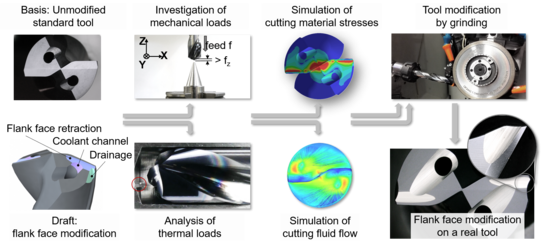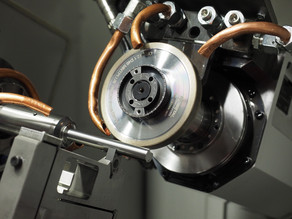Investigations on Optimisation of the Cutting Edge of Twist Drills for the Machining of the High Temperature Resistant Nickel-Base Alloy Inconel 718
When drilling difficult-to-machine materials, such as Inconel 718, productivity is limited in particular by the cutting parameters that can be used. If these are not chosen moderately, the tool life is drastically shortened and the machining quality decreases. In order to shift this economic production limitation, this project pursues the scientific approach of modifying the flank face of solid carbide drilling tools. This geometrical change consists of retractions on the flank face which are introduced by grinding technology and which direct the cutting fluid specifically in the direction of the cutting edge of the tool. Increased flow speeds in the area of the cutting edge corners improve heat dissipation from the point of action, which reduces the thermal load on the cutting material. This also results in less influence on the manufactured subsurface zones, which are often characterized by a white layer and hardening zones, especially at high cutting values. The aim of this project is the development and application of the flank modification in order to increase the productivity of the drilling process and to minimize cost-intensive reworking.
In the investigations carried out so far, the thermomechanical loads acting on the cutting edge were determined in order to geometrically design the flank face modification. For this purpose, a CAD model of the modified tool was created and FEM simulations were used to ensure that the real tool would withstand the process in spite of its weakened cutting edge. CFD analyses have also shown that the flow of cooling lubricant is significantly improved by the introduction of a relief on the flank face. The modification was carried out on a tool grinding machine from Schütte and the modified tools were subsequently used. In these experimental investigations it was proven that tools modified in this way have significantly lower cutting edge temperatures and considerably longer tool lives compared to standard tools. These effects were particularly pronounced at high cutting speeds. A significant reduction of cutting fluid coking behind the main and secondary cutting edges indicates an improved cutting fluid supply in these areas, which leads to more effective cooling and lubrication. This can also be proven by the significant reduction of material adhesion on the guide chamfers of the tools, which significantly improved the achievable bore quality.
In further investigations, the cutting fluid flow behaviour on the tools is being investigated experimentally in order to validate the findings obtained on the basis of simulation. In addition, the influence of a coating of the grooves on flank face is being investigated, which can be assumed in an industrial application of the concept. Parallel to this, alternative methods for introducing a flank face modification on solid carbide twist drills will be examined.





![[Translate to English:] [Translate to English:]](/storages/isf-mb/_processed_/a/1/csm_Wendel_Tiefbohrer_51a08eea1c.jpg)